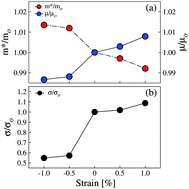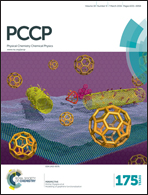Polarization effects on the interfacial conductivity in LaAlO3/SrTiO3 heterostructures: a first-principles study†
Abstract
We studied the influence of uniaxial [100] strain (−1% to +1%) on the electron transport properties of a two-dimensional electron gas (2DEG) at the n-type interface of the LaAlO3/SrTiO3(LAO/STO) heterostructure (HS)-based slab system from the perspective of polarization effects via first-principles density functional theory calculations. We first analyzed the unstrained system, and found that the induced polarization toward the vacuum in the LAO film leads to a small charge carrier density on the order of 1013 cm−2 (less than the theoretical value of 3.3 × 1014 cm−2 from the superlattice-model-based polar catastrophe mechanism), which is in excellent agreement with the experimental values of oxygen-annealed LAO/STO HS samples. Upon applying [100] tensile strain on the STO substrate, we found a significant reduction of the induced polarization in the LAO film. This reduction weakens the driving force against charge transfer from LAO to STO, causing an increase in the interfacial charge carrier density. The uniaxial strain also leads to a decrease of the effective mass of interfacial mobile electrons, resulting in a higher electron mobility. These findings suggest that applying uniaxial [100] tensile strain on the STO substrate can significantly enhance the interfacial conductivity of the LAO/STO HS system, which gives a comprehensive explanation for experimental observations. In contrast, compressively strained LAO/STO systems show stronger LAO film polarization than the unstrained system, which reduces the interfacial charge carrier density and increases the electron effective mass, thus suppressing the interfacial conductivity.



 Please wait while we load your content...
Please wait while we load your content...